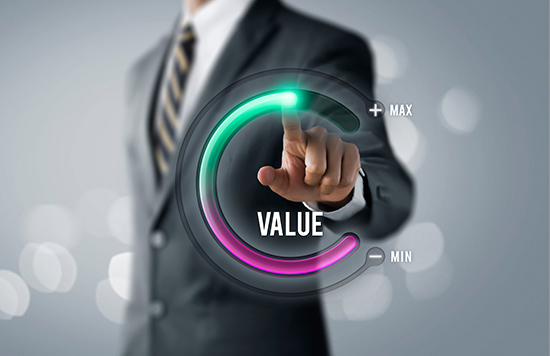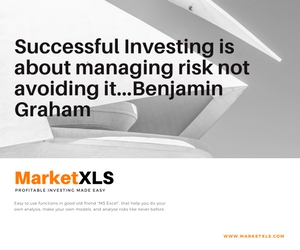Many studies have shown that the number one factor in producing outsize return on investment is the original purchase price of a security. In other words, the old adage still holds true, “You don’t make money when you sell…you make money when you buy.” But traditional valuation tools and techniques are often useless for today’s early stage biotech innovators. How do you make sure that you are getting a good deal before you invest your hard earned capital? Using Syros Pharmaceuticals, Inc as an example, we identify some tactics for gauging value on today’s biotech innovation scene…
Just how much do you think the word, “maybe” could be worth? Believe it or not, there is a price attached to the word “maybe” and fully understanding the pros and cons of that price will be key to your success in early stage biotech investment.
Traditional stock market valuation techniques rely on metrics related to either revenue or cash flow. Have you ever heard the phrase, “stock x is trading at 12 times earnings?” This means that if you bought stock x at price y, you would be paying the equivalent of 12 times that company’s annual earnings. This is called Price to Earnings ratio (PE ratio). It is a great starting point for the valuation of traditional, profitable, companies, because it allows for easy comparison between peer companies, or even different industries. For example, if the average PE ratio in the Big Pharma industry is 14, and your target company is trading at 17, then either your target company is offering something truly special, or it’s just overpriced. Vice versa is also true. If the average PE ratio amongst a group of similar Big Pharma companies is 14, and your target company is 10, you are either going to be getting a great deal, or the company is cheap for a reason.
What about when a company is not yet making money? We have heard a lot about these kinds of scenarios of late, due to the “Unicorn” IPO phenomena. For example, Uber has billions and billions of revenue, but (sadly) no profit. So, the value of Uber, as opposed to a similar rival (LYFT) has been expressed as a multiple of revenue, instead of profit. Whether this is a good idea at all remains to be seen, but this kind of metric is common and well understood amongst companies that are thought to be generating cutting edge technology. For example, according to NYU Stern school of business, the average biotech firm trades at 5.87 times sales. If you believe you are investing in a commercially viable start up that just hasn’t quite hit profitability yet, this allows an investor to “shop around” and gauge whether or not a young company is properly valued.

But what if a company is so young, so raw, that it doesn’t even have revenue yet?
What??? Why would a company with no profit, and not even revenue, be trading publicly to begin with? Why on earth would you want to invest in a company that hasn’t even brought in a single dollar yet?
PHARMACEUTICALS AS REAL ESTATE
Before we go any further, let’s be clear: investing in any pre-revenue company is risky business. If you choose to bet on this kind of company, you are hoping to buy into world changing innovation early, while the price is still low, before the rest of the world discovers what is going on in the company’s laboratories. You are taking a calculated risk, because any perceived value is theoretical, and based on things that you think will happen.
In this kind of scenario, biotech companies are much more like real estate development companies. Except, instead of developing communities or shopping malls, they are developing molecules. A real estate development company seeks to create physical projects that will eventually generate tangible, real revenue. But it may have to invest for years before any one project becomes obviously viable. It’s the same scenario for a young biotech.
Try this mental exercise. You walk through a gentrifying part of town, and you notice a ramshackle building on a choice corner lot. The location is obviously great, but right now it’s not worth much because the lot is occupied by a slum. The next month, you walk by the same lot, and you notice the slum has been razed, and there is a shiny new sign saying “coming soon, luxury rentals.”
At that moment, the developer has already sunk huge amounts of money into purchasing the lot, razing the slum, and obtaining plans and permitting to move forward with a speculative new development. They haven’t put one piece of rebar in the ground yet…revenue is far away. But does that mean the project has no financial value? Or, in fact, does it have a larger value than it did when it was just a slum, because substantial progress has already been made? This is just the same as a young biotech with novel agents in early clinical testing.
Now let’s say, six months later, you walk by the same lot, and you notice that construction has begun, and a towering rental building is half built. Still, little tangible cash flow for the developer, and certainly no profit. Does that mean no real financial value? Is the lot worth more than it was six months ago, when it was a barren slum, or more, now that it’s halfway to being a brand new venture? This would be the equivalent of a pre-revenue biotech with agents that have passed through some important trials, but are not yet ready for launch.
Finally, a year after you first laid eyes on the property, you see a tower has been mostly completed. At least the outside is all done, and the developer is planting trees and grass around the property…a new sign is up proudly pronouncing, “coming soon.”

All this progress, but still no revenue, and certainly no profit! But would the value of the project be more than when it was only half built? This would be a biotech with an agent, or agents, that have just passed stage three testing, and about to file for FDA approval. Although the young company still hasn’t made a dime in tangible profit, the venture obviously now possess assets that have greatly increased in value.
The reason why these kinds of companies would want to be public would be to provide some liquidity to management and scientific teams that can toil for years to build up the company’s scientific assets. Let’s say you are a chief medical officer, and you joined the young biotech when it’s novel agent was still being tested in rats. Now you have a candidate that has made it all the way through phase two testing. This means that your work has consistently increased the value of the company’s assets for quite some time, even if this work has not yet resulted in revenue for the company. In fact, from “preclinical” to phase two could take years. But you have bills that need to be paid today. By earning shares in a young, pre-revenue company, you can keep paying your bills until your big breakthrough finally comes. Simply put, young companies that allow shares to trade publicly may well increase the patience and financial endurance of their high value executive teams. Revenue or not, value is being created as a drug marches along the development process, and share based compensation helps a young company make that value tangible for employees and early investors.
MEASURING VALUE: The Example of SYROS
One such example would be Syros Pharmaceuticals, Inc. ($SYRS). Syros is a fledgling biotech, working to pioneer a method of modulating expression of genes. The theory would be that certain genes in your DNA can be turned on, turned off, turned up, or turned down, like the volume on a stereo. This would allow the company to treat all kinds of diseases that currently have a poor prognosis.
I was originally attracted to the company for a few reasons. First, I liked the company’s focus on unmet medical needs and innovation. Second, the company boasts an experienced “who’s who” team of executives with a strong track record in new drug innovation. Third, most importantly, I felt that I was getting a deal on the shares. In the last year, Syros’s shares have fallen from over $12 to under $6. I bought hoping that I was getting viable innovation at half off.
Much like the promising real estate development that is only half done, there is value here. But value is in the eye of the beholder; in the absence of steady profit, or even steady revenue, traditional valuation techniques break down. I will share with you my value appraisal process; the goal is to find value that the stock market is missing.
The formula could be expressed as the following:
POTENTIAL REVENUE FROM ASSETS x NUMBER OF ASSETS X PROBABILITY OF SUCCESS
For the purpose of this analysis, we will exclude any “preclinical” assets. These are very young molecules that are still being tested in mice, or in cell cultures. While these compounds also have value, the valuations are so murky that even I don’t dare to assign a number.
Syros currently has two novel assets being tested in human beings. SY-1425, and SY-1365. The first number to contemplate is the financial potential for these two candidates.
SY-1425 is being tested for AML, a kind of Leukemia that mostly strikes older adults. According to Cancer.org, there are about 20,000 new cases diagnosed each year in the United States, and about 10,000 deaths from AML. So, Syros is looking to treat a highly deadly disease whose prevalence will only grow with the ageing of the American population. If such a drug were successful at all, it could easily generate $1,000,000,000 in annual sales.
The second agent, SY1365 is being tested for relapsed ovarian and breast cancer. This would mean female cancer patients who have already failed other treatments, and are near death. Is there anyone who is not familiar with the Susan G. Koman foundation and the Pink Campaign? So a successful drug in this realm could generate $1Billion without breaking a sweat….
So, that would mean that tiny Syros is easily looking at $2,000,000,000 in revenue if it’s two most advanced agents find success. However, that is a big “IF.” According to a report from the Biotechnology Innovation Organization, between 2005 and 2015, drugs currently in phase one testing only had a 10% chance of making it all the way to FDA approval. Drugs currently in phase two testing had a 30% chance. So, before we start counting our biotech riches, let’s handicap those profits. If SY1465 has a $1B potential, and it’s currently in phase two testing, let’s value it at 30%x $1B, or $300 Million. If SY1365 also has a $1Billion potential, but it’s only in phase one testing, let’s value that one at $1Billionx10%, or $100Million.
As our last step, we add up those potential assets to attempt to reach a realistic value for all of Syro’s “work in progress.” If SY-1425 were worth $300Million, and SY1365 were only worth $100Million, then the company’s current R&D assets could be worth $400Million.
As of June 7th, 2019, Wall Street only valued the whole company at $243 Million. Twelve months ago, when Syros’s assets were actually less advanced, Mr. Market valued the company at $500Million. Did I buy value when I bought at a discount?
I hope so.
“Maybe” is such a powerful word. The hopes and dreams of billions of people hang on those five letters. But don’t let “maybe” be a guessing game. Mastering “maybe” is what separates the successful biotech investor from the casino gambler. Master “maybe” and you WILL find success…
DISCLOSURE: The Sick Economist owns shares in $SYRS





More Stories
5 WAYS THAT BIOTECH CAN ATTACK ALZHEIMER’S
3 PROMISING BIOTECHS FOR THE YEAR 2025
IOVANCE BIOTHERAPEUTICS & GOOD MATH